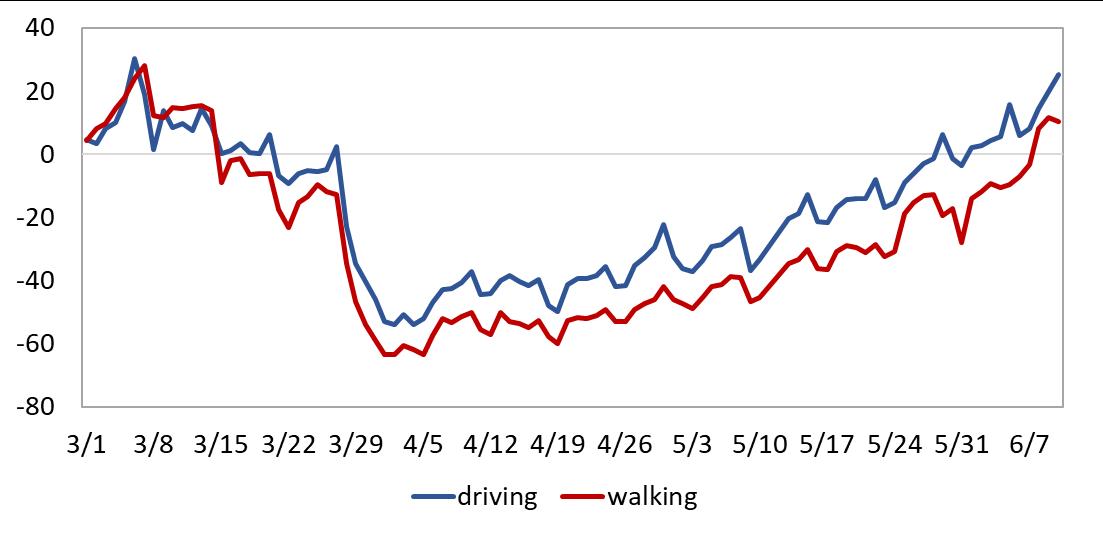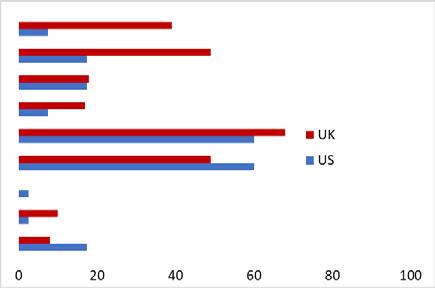
9 minute read
4. Vulnerability of Armenian migrants in Russia
the targeting formula used to determine eligibility assigns lower scores for every member absent from the households not for military service10 . In addition, Armenian migrants would not be eligible to unemployment benefits and other earning-related social insurance benefits in Armenia.
During the COVID-19 pandemic, Armenian workers in Russia are likely to be in precarious situations, as the Russian economy contracts. As of mid-June, Russia starts to experience, as other European countries, a decline in new COVID-19 cases and Moscow is easing containment measures amid strong economic blow from measures to control the spread of COVID-19 and from falling oil prices (see Figure 3 on the timeline of containment measures). Russia’ GDP fell by 12 percent during the first four months of 2020, compared to the same period of 2019 according to the Ministry of Economic Development. Its GDP growth is projected to fall by – 6 percent (World Bank, 2020a). While economic activities are resuming and people mobility returns to an early March level (Figure 4.a), activities in workplaces are yet to resume to the January level (based on people mobility in workplaces, Figure 4.b) and downside risks remain because of second or third waves of infections.
Advertisement
Figure 3. Number of COVID-19 cases in Russia and timeline of containment measures in Moscow
Source: Wikipedia. https://en.wikipedia.org/wiki/COVID-19_pandemic_in_Russia#Statistics
10
The international migration literature suggests that, while migration occurs in lower income households, international labor migration is costly and therefore the bottom poor is less likely to be part of it, owing to their financial constraints.
Figure 4: Russian People mobility in workplaces is yet to fully recover to the pre-COVID level
(a) In June people mobility has recovered to the early March level (percent change from January 13, 2020) …
Source: Apple index.

(b) … but people mobility in workplaces is, on average, still below the January level (percent change from the January baseline)
20
10
0
-10 2/15
-20
-30
-40
-50
-60
-70
-80 2/22 2/29 3/7 3/14 3/21 3/28 4/4 4/11 4/18 4/25 5/2 5/9 5/16 5/23 5/30 6/6 6/13 6/20
workplaces_percent_change_from_baseline 14 per. Mov. Avg. (workplaces_percent_change_from_baseline)
Source: Google mobility index.
Armenian migrants in Russia could face substantial risks of losing jobs during this crisis, owing to disruptions in construction activities. As shown in Figure 5.a, eight out of ten Armenian migrants in Russia work in the construction sector. In Russia, projections of jobs at risk by sector is not available, to our knowledge. The Ministry of Economic Development, nonetheless, reports that construction is a hard-hit sector, together with personal services – for instance, a decline of taxi calls by 70 percent.11 The dent in the construction sector may owe to the shutdown of construction and repair activities initially planned for a week in April in Moscow, then extended to May 12, 2020, except the construction of medical facilities, public transport and airports.12 In the United Kingdom (UK), the construction sector is projected to receive a relatively hard hit – 39 percent of jobs at risk of displacement for COVID-19 containment measures (Allas et al, 2020; Figure 5.b). On the other hand, Chmura’s COVID-19 Economic Vulnerability Index reports that in the US, the construction sector is to be relatively insulated from risks of job loss (job loss risks ranging between 5 and 10 percent), unlike sectors requiring face-to-face interactions such as accommodation and food service(Figure 5.b). Using these two projections, we estimate that some 9-37 percent of Armenian migrants are likely to lose jobs during this pandemic, using the sectoral number of Armenian migrants in Russia obtained from ILCS 2018. Strong downside risk is plausible, considering that most Armenian construction workers in Russia are semi-skilled. In Europe, some 80 percent of jobs at risk are held by those who do not have university or higher education (Chinn et al, 2020).
Figure 5. Economic activities of Armenian migrants in Russia
(a)
Distribution of Armenian migrants by sector
(b) Proportion of jobs at risk in UK and US, by sector
Source: ILCS 2018; Chmura’s COVID-19 Economic Vulnerability Index for the US, Allas et al., 2020 for the UK (McKinsey Global Institute).


Returns of Armenians from Russia may shed light on the extent of job losses. Departures of Armenians from Russia were 15,572, an increase by 94.1 percent during the first quarter of 2020, compared to the same period in 2019 (according to Russia Social-Economic condition statistics of April 2020). According to a sample survey study carried out by the Institute of Applied Economic Research (RANEPA) of Russia, more than half of migrants in Moscow lost jobs or furloughed, and a third lost their livelihoods. Only one in ten
11 Overall the unemployment level jumped in Russia: the number of registered unemployed people spiking by 59.2 percent in April, compared to March (or a drop by 79 percent compared to April 2019); and it is expected to increase yet again by 46 percent in May, compared to April, according to the Ministry of Economic Development. 12 https://www.rbc.ru/economics/20/04/2020/5e99977a9a79476eebb62cd5 (in Russian). In Russia, the decisions on shutdown of construction and repair activities are delegated to regions as well as other key responsivities related to COVID response. Responses varied by region. According to anecdotal evidence, around 41 regions (about half of the regions) have not introduced any limitations on construction, while the other half did introduce limitations of various forms and scope.
reported no change in financial situations during the COVID-19 crisis, according to RANERA. The lack of written employment contracts may increase the likelihood to lose jobs: many of Armenian migrants do not have a written employment contract which would be a means to project labor (Figure 6).
Figure 6. Armenian migrants in Russia are vulnerable during economic downturns (percent of the current Armenian migrant sample in Russia. Scale – zero (starting at the center) to 100 percent)
Source: RAU 2018 survey dataset.

Furthermore, migrants would face greater risks of being infected by the virus, owing to their over-crowded accommodations. Migrant construction workers commonly stay in dormitories or hostels which tend to be over-crowded and thus self-isolation, quarantine, and social distancing would become challenging. Singapore saw that over-crowded migrant worker housings becoming epicenters of virus infections. As shown in Figure 6, only 16 percent of current Armenian migrants live in their own housing or in relatives’ or acquaintances’ homes13, and majority of them live in a rental housing or rented rooms. These rental housing would pose an additional risk of being evicted, owing to loss of income. Taking this precarious situation of migrant workers, in UAE, the government suspended rental property eviction cases. A similar measure was put in place by Spain as well for vulnerable groups including migrants.
Migrants are exposed to infection risks while sending money home. As many other labor migrants do, Armenian migrants in Russia opt money transfer operators (MTOs) to send their earnings to family members in Armenia14. Access points for transfer transactions are MTO agents, which require person-to-
13 It should be noted that these housings could be also crowded. 14 Armenian banks and payment institutions act as an agent network for the international money remittance systems (total 10 systems, including Moneygram, Unistream, etc.) and Armenian money remittance systems (ConverseTransfer and Telcell transfer). In order to reduce the cost of money transfers, strengthen financial stability and provide better risk management, the Central Bank of Armenia has decided to create the centralized system ‘’STAK’’ for the clearing of remittances (domestic and international) with the settlement happening in the central bank money. Participants in the ‘’STAK’’ will comprise all Armenian banks and payment institutions, international MTOs, foreign financial institutions, as well as local MTOs. The development of ‘’STAK’’ has reached
person interactions. In order to reduce health risks during remittance transactions, Qatar, for instance, mandated all remittance transactions to be an online-based service and companies to educate migrant workers on how to use such online service (Moroz et al., 2020). MTOs in Russia offer a low-cost service to send money to Armenia15. Nevertheless, UN agencies calls for zero remittance cost for labor migrants during the pandemic, to support their livelihoods.16
Armenians who lost jobs due to COVID-19 are likely to have little social protection in Russia. First, given that about 10 percent of current Armenian migrants registered their activities (Figure 6), it is very unlikely that unemployed Armenians would be eligible for the Russian subnational (regional) government’s emergency support programs for the self-employed or unemployment benefits. Second, as being foreigners, they would be ineligible for other livelihood measures the Russian government has introduced, such as public works and targeted transfers. To support migrants’ employment, the Russian government issued that foreigners can be hired without patents, do not need to pay for patents that are already issued, and move to another region to search for work17. But it is unclear, to what extent, these measures have assisted those laid-off migrants. Third, many Armenian migrants do not have health insurance (Figure 6); by law, they have access to COVID-19 testing and treatment, but RANEPA finds that migrants do not often receive medical service, suggesting limited access to COVID-testing and treatment facilities, de facto.
Furthermore, migrants are also at risk of being trapped by travel restrictions put in place by both Russia and Armenia. In other words, they lost jobs or completed their employment terms, but have been unable to leave Russia as borders are closed. While Russia permitted that foreigners have the right to remain in Russia until June 15, irrespective of the duration of their permits, these migrants may have insufficient financial capacity to support their shelter and food, without jobs, given that they have remitted a large sum of their earnings to family members in Armenia. To mitigate this vulnerability, Qatar, for instance, provide free shelter and food to labor migrants in such a situation from the government’s budgets, until travel situations get resolved.
Unemployed Armenian workers may not benefit from an increase in new recruitments in Russia. The economy has been seeing a sharp uptick in new recruitments by firms. Most of these companies, including large multinational ones, are in the e-commerce industry or related to the consumption of goods and services which takes place on-line. Other growing sectors include food delivery and IT-related companies that serve internet traffic and work with big data, according to the Ministry of Economic Development18 , as the new normalcy under COVID-19 generates forces to increase the efficiency of flexible and remote work (employment), through a greater use of digital technologies. However, these are not economic sectors where Armenian migrants are currently engaged in. Currently, Armenian migrants have nearly zero presence in the information related sector in Russia, and their education level tends to be biased toward semi/low-skilled. As Figure 6 shows, less than half of Armenian migrants use an internet-based means to communicate with their family members in Armenia. Therefore, upskilling and reskilling of migrant workers might be warranted to benefit from this emerging labor reallocation force.
an advanced stage, where the vendor has been onboarded, and connection tests between the system and banks, as well as domestic and international MTOs have been conducted 15 World Bank Remittance Prices Worldwide reports that the cost to remit USD 200 from Russia to Armenia is 1.7 percent of the transaction amount, as of the first quarter of 2020, which remains below the 3 percent target under the Sustainable Development Goals. 16 Accessed at https://eurasia.expert/denezhnye-perevody-migrantov-mogut-stat-besplatnymi/ 17 This measure has been extended to September 15, 2020. 18 Accessed at http://politcom.ru/23832.html.




